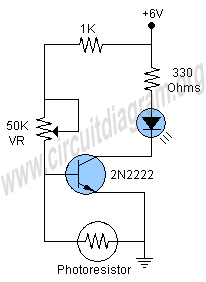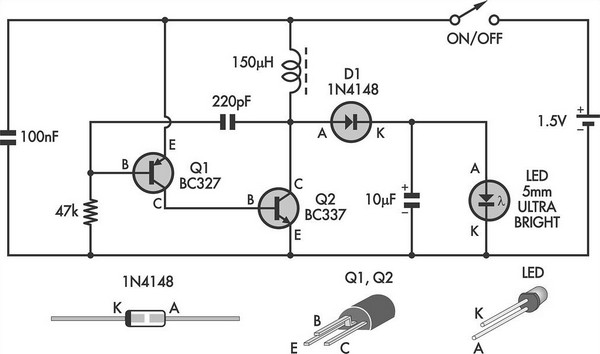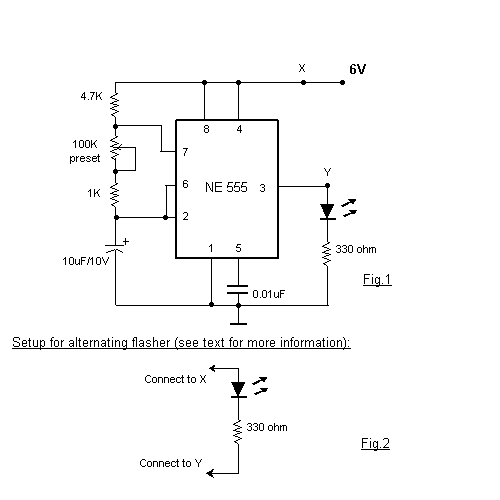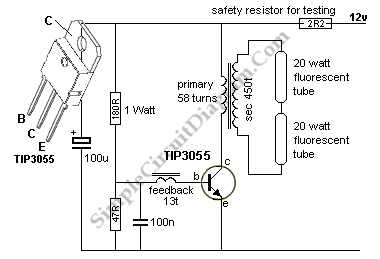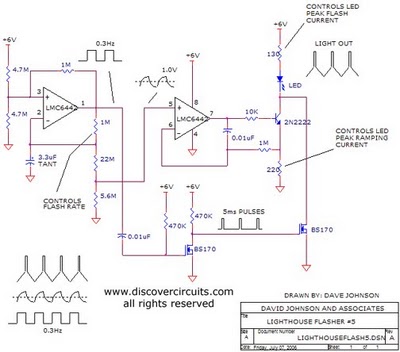
LED or Lamp Flasher
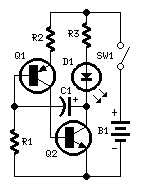
Flashing frequency can be varied by changing R1 value in the 1M - 4M7 range. This circuit is very efficient when driving a small 3.2V incandescent lamp. In this case omit the LED and R3, connecting the bulb across Q2 Collector and positive supply, further reducing parts counting. Maximum current drawing of the bulb type used should not exceed 100mA. In order to facilitate oscillation when a bulb is driven, R2 value should be lowered to 82R or 68R.
The described circuit is a simple oscillator designed to control the flashing frequency of a load, specifically a small incandescent lamp rated at 3.2V. The core component of the circuit is a transistor, likely configured as a switch, which facilitates the on-off cycling of the lamp.
The flashing frequency is adjustable by varying the resistance of R1, which is specified to be in the range of 1MΩ to 4.7MΩ. This resistor affects the time constant of the circuit, thereby altering the frequency at which the lamp turns on and off. A higher resistance value will result in a slower flashing frequency, while a lower resistance value will increase the frequency.
When using the circuit to drive the incandescent lamp, it is recommended to omit the LED and resistor R3. Instead, the lamp should be connected directly across the collector of the second transistor (Q2) and the positive supply voltage. This modification not only simplifies the circuit by reducing the number of components but also enhances the efficiency of the circuit by allowing the lamp to be driven directly without additional load from the LED.
It is crucial to ensure that the maximum current drawn by the lamp does not exceed 100mA. Exceeding this current limit could damage the transistor or the lamp itself, leading to failure of the circuit.
To facilitate stable oscillation, especially when driving the lamp, it is advised to lower the value of resistor R2 to either 82Ω or 68Ω. This adjustment helps to optimize the circuit's performance, ensuring reliable operation and consistent flashing behavior of the lamp.
Overall, this circuit provides a straightforward solution for controlling the flashing of a small incandescent lamp, with flexibility in frequency adjustment and minimal component requirements.* Flashing frequency can be varied by changing R1 value in the 1M - 4M7 range. * This circuit is very efficient when driving a small 3.2V incandescent lamp. In this case omit the LED and R3, connecting the bulb across Q2 Collector and positive supply, further reducing parts counting. * Maximum current drawing of the bulb type used should not exceed 100mA. * In order to facilitate oscillation when a bulb is driven, R2 value should be lowered to 82R or 68R.
🔗 External reference
The described circuit is a simple oscillator designed to control the flashing frequency of a load, specifically a small incandescent lamp rated at 3.2V. The core component of the circuit is a transistor, likely configured as a switch, which facilitates the on-off cycling of the lamp.
The flashing frequency is adjustable by varying the resistance of R1, which is specified to be in the range of 1MΩ to 4.7MΩ. This resistor affects the time constant of the circuit, thereby altering the frequency at which the lamp turns on and off. A higher resistance value will result in a slower flashing frequency, while a lower resistance value will increase the frequency.
When using the circuit to drive the incandescent lamp, it is recommended to omit the LED and resistor R3. Instead, the lamp should be connected directly across the collector of the second transistor (Q2) and the positive supply voltage. This modification not only simplifies the circuit by reducing the number of components but also enhances the efficiency of the circuit by allowing the lamp to be driven directly without additional load from the LED.
It is crucial to ensure that the maximum current drawn by the lamp does not exceed 100mA. Exceeding this current limit could damage the transistor or the lamp itself, leading to failure of the circuit.
To facilitate stable oscillation, especially when driving the lamp, it is advised to lower the value of resistor R2 to either 82Ω or 68Ω. This adjustment helps to optimize the circuit's performance, ensuring reliable operation and consistent flashing behavior of the lamp.
Overall, this circuit provides a straightforward solution for controlling the flashing of a small incandescent lamp, with flexibility in frequency adjustment and minimal component requirements.* Flashing frequency can be varied by changing R1 value in the 1M - 4M7 range. * This circuit is very efficient when driving a small 3.2V incandescent lamp. In this case omit the LED and R3, connecting the bulb across Q2 Collector and positive supply, further reducing parts counting. * Maximum current drawing of the bulb type used should not exceed 100mA. * In order to facilitate oscillation when a bulb is driven, R2 value should be lowered to 82R or 68R.
🔗 External reference
